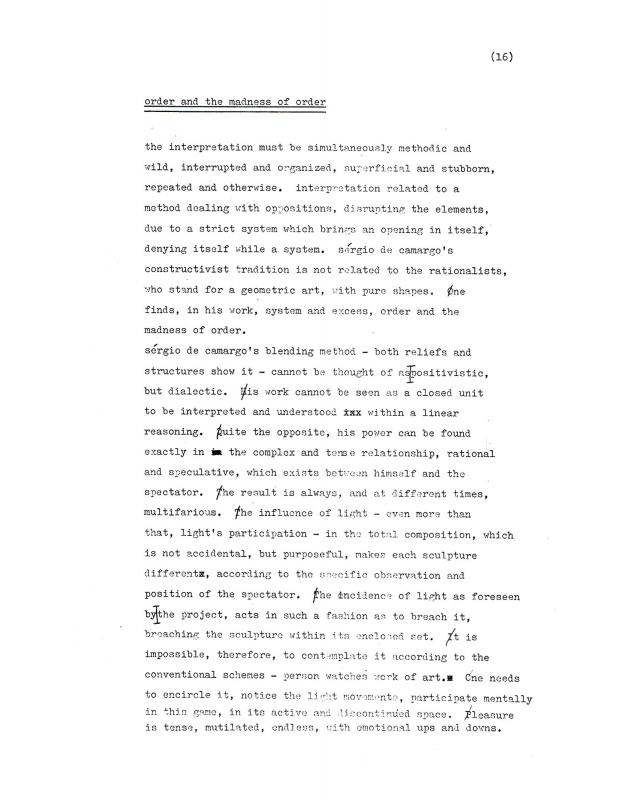Jean Clay (French art historian, critic and journalist) was the publisher of the Parisian journals Robho and Macula, the latter with the art historian born in Algeria Yve-Alain Bois (b. 1952). During the 1960s, he sought out Brazilian art in Paris, becoming a huge enthusiast of the experimental artwork of Lygia Clark (1920–88). Clay was also the critic who disseminated the artwork of another Brazilian artist, Hélio Oiticica (1937–80) (publishing the work of both artists in Robho), as well as that of Sérgio Camargo (1930–90), about whom he wrote a book in 1968. Like Jean Clay, the English critic Guy Brett (b. 1942) became associated with the work of Clark and Camargo from their beginnings, in addition to Kinetic trends, whether that of GRAV [Groupe de Recherche d’Art Visuel] or of Venezuelan Kinetic Art. Curiously, the large format of the journal Robho was the brainchild of Carlos Cruz-Díez. There are other readings of this sculptor, one set forth in the essay “Camargo,” published in Signals Newsbulletin, No. 5 (London, December 1964) [see doc. no. 1111304]; as well as another essay by Brett, in which he analyzes the luminous textures created by “Camargo,” which was subsequently published in Sérgio Camargo: Luz e Sombra (São Paulo: Arauco, 2007) [doc. no. 1232285].
The journal Robho, published in Paris between 1967 and 1971, was founded by Clay along with the artist Julien Blaine. Together, the two published this journal focused on Kinetic art and guerilla theater and made up of interviews, writings by artists, critical essays and a fair amount of photography. Robho covered the activities of art groups around the world such as the Brazilian Neo-Concrete artists; the project Tucumán Arde, created by Argentine artists; the Japanese group Gutai; and other art groups in New York, San Francisco and Paris.
The journal Macula, published in Paris between 1974 and 1979, was founded by Jean Clay along with the art historian Yve-Alain Bois. The themes of each issue varied within the sphere of institutional criticism and conventional art history, which the publishers called upon to question both the thinking behind and the interpretation of contemporary art. Macula included texts contributed by Lygia Clark, Kazimir Malevich, Josef Albers and Piet Mondrian, alternating with texts by art critics of the time or earlier texts reissued in the journal by Walter Benjamin, Rosalind Krauss, Clement Greensberg and the publishers, themselves. The fact that Macula also published philosophy texts by Martin Heidegger and Jacques Derrida in some of its issues is evidence of the breadth of its influence.
In addition, the Brazilian critic Ronaldo Brito wrote on the dialectic method at work in the “reliefs” by Camargo in his study “Order and the madness of order” [doc. no. 1110496].


